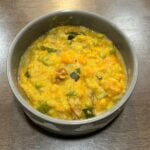Feeding your dog a vegetarian diet is a controversial practice. It is imperative that you speak with your veterinarian or a canine nutritionist before feeding your pup to this vegetarian dog food recipe.
While some canine nutrition experts say it's a healthy option, others claim there is no way to feed a dog a healthy vegetarian diet. Research has been done on vegan and vegetarian diets for dogs, and it's clear that these diets should only be used when absolutely necessary.
The concern with this diet is that it does not provide 100% of the nutrition that a dog needs. That's why it is vital to your dog's health to consult your veterinarian or a certified canine nutritionist before switching your pet to a vegetarian dog food recipe.
An expert in canine nutrition will recommend additional supplements to add to your pup's vegetarian diet that will make up for the lacking nutrients. When done correctly, a vegetarian dog food diet can be a very healthy way to feed your canine companion.
DIY Vegetarian Dog Food Recipe
 If you've already cleared this diet with your veterinarian, this vegetarian dog food recipe could be a great addition to your pet's diet. Keep in mind that it is not 100% nutritionally balanced, so you'll need to add the required supplements before feeding it your pooch.
If you've already cleared this diet with your veterinarian, this vegetarian dog food recipe could be a great addition to your pet's diet. Keep in mind that it is not 100% nutritionally balanced, so you'll need to add the required supplements before feeding it your pooch.
DIY Vegetarian Dog Food Recipe
There may be several reasons to choose to feed your dog a vegetarian or vegan diet. The most common reasons are ethical (if the owners are vegetarian, they wish the same for their pets) or health related reasons.
No matter the reason, it's important to discuss this dietary change with your veterinarian or a certified canine nutritionist. It's unlikely that any vegetarian dog food recipe will provide adequate nutrition for your pet.
A canine nutrition specialist will discuss adding supplements to this recipe to make it nutritionally balanced to meet your dog's unique needs.
- Prep Time: 15 minutes
- Cook Time: 20 minutes
- Total Time: 35 minutes
- Yield: about 12 cups of food 1x
- Category: Cooked Food
- Method: Pressure Cooker
- Cuisine: Dog Food
- Diet: Vegetarian
Ingredients
- 2–3 sweet potatoes (chopped)
- 2–3 small zucchinis or 2 large zucchinis (chopped)
- 6–8 carrots (chopped)
- 2 tablespoons peanut butter
- 1 can peas (drained)
Instructions
Place 1 inch of water in your pressure cooker. Add all of the vegetables and cook on high pressure for 20 minutes.
Once it's safe to do so, remove the lid and add the peanut butter and peas to the recipe. Using a potato masher, mash all of the ingredients until well combined.
When the food has cooled, you can feed it to your pup.
Nutrition
- Serving Size: 1/2 cup
- Calories: 74
- Sugar: 2.4 g
- Sodium: 27 mg
- Fat: .8 g
- Carbohydrates: 15.3 g
- Fiber: 3 g
- Protein: 2 g
- Cholesterol: 0 mg
Serving Size Recommendation
You can serve this food to your dog as soon as it has cooled. I recommend feeding about 1 cup of food for every 20-25 pounds of body weight.
This recommendation is for 2 servings per day. So, a 25-pound dog would eat about 1 cup in the morning and 1 cup in the evening.
This is just a guideline.
Some dogs, like working dogs and very active breeds, will need more calories than this. Lazier pets and senior dogs may not need as many.
It's best to consult your veterinarian about the appropriate serving size for you dog. They will also help you evaluate the meal to make sure it will meet your pet's unique nutritional needs.
If necessary, they will assist you in choosing the best supplements and/or multivitamins to add.
How to store
You can store the leftover vegetarian dog food recipe in an airtight container in the refrigerator for 3-5 days or freeze them, and they’ll keep for up to 3 months. Keep in mind that this recipe includes no preservatives, so it won't last nearly as long as commercial dog food.
For More Information
We publish many homemade dog food and treat recipes every month. For more recipes, pet food cooking tips, and advice, see our “Recipes” section.
If you're new to home-cooked dog food subject, I recommend you read more about “How Much To Feed” to understand serving sizes, “What Supplements To Use” to create well-balanced meals, and “How To Store” for tips on simple and easy homemade dog food storing in a fridge or a freezer.













